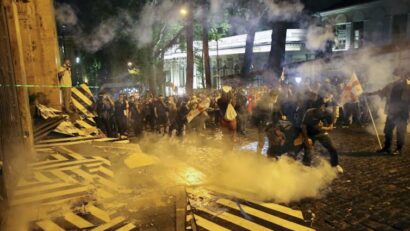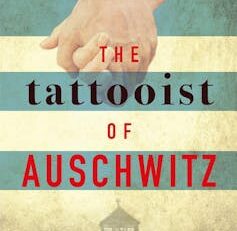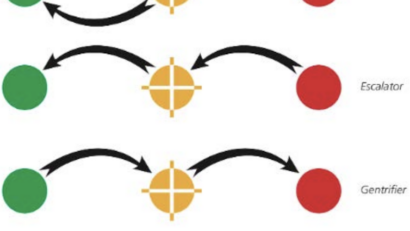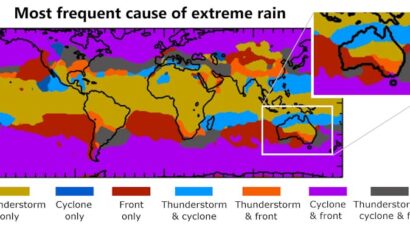This month, the much-anticipated television adaptation of The Tattooist of Auschwitz premiered on Australian streaming platform Stan. Before its release, significant publicity announced it as an all-star production: Melanie Lynsky and Academy Award nominee Harvey Keitel in leading roles; an original score by Academy Award winner Hans Zimmer; an original song written and sung by Barbara Streisand. The series has been applauded as a “courageous, unforgettable, human story” and as both “a love story and reminder of the Holocaust and its horrors”.
The book on which the series is based was published in 2018 by the Australia-based, New Zealand-born author Heather Morris. The Tattooist of Auschwitz has been translated into more than 40 languages and sold millions of copies worldwide. It tells the story of Ludwig “Lali” Sokolov (né Eisenberg), as recounted to Morris over three years of personal meetings.
A Slovakian Jew, Sokolov was transported in 1942 to Auschwitz-Birkenau. He was eventually assigned the role of Tätowierer at the camp, tattooing individual prisoner numbers on the forearms of thousands of new arrivals. While tattooing, Lali met Gita Fuhrman, also a Jewish deportee from Slovakia, and the pair instantly fell in love. “I tattooed her number on her left hand, and she tattooed her number in my heart,” Lali told Morris.
Both survived almost three years in Auschwitz and, after a period of separation, were reunited in Slovakia. Lali and Gita married and, in 1949, emigrated to Melbourne, where they raised their son and made a new life for themselves.
Following the success of The Tattooist of Auschwitz, Morris released a sequel Cilka’s Journey (2019), and later Stories of Hope (2020) and Three Sisters (2021), adding to an ever-expanding genre of stories of love and hope set in Auschwitz – one that includes works such as Roxane van Iperen’s The Sisters of Auschwitz (2019), Ellie Midwood’s The Girl who Escaped from Auschwitz (2021), Keren Blankfeld’s Lovers in Auschwitz (2024) and Lidia Maksymowicz’s A Little Girl in Auschwitz (2023).
The six-part television adaptation of The Tattooist of Auschwitz, directed by Tali Shalom-Ezer, joins a well-established genre of cinematic representations of Holocaust histories focused on love stories that includes Sophie’s Choice (1982), Life is Beautiful (1997) and The Reader (2008).
Based on – or inspired by?
Despite its international success, the book of The Tattooist of Auschwitz generated a lot of controversy. The main criticism related to its historical inaccuracies.
Morris initially claimed 95% of the account was factual. She insisted she had only fictionalised scenes where she put Lali and Gita “into events where they really weren’t”. Historians remained sceptical. They soon revealed Morris had uncritically relied on Sokolov’s account, failing to verify key details. Some reviewers even claimed she had intentionally and unethically manipulated Sokolov’s testimony.
Relatives of some of the characters, including the couple’s son Gary Sokolov, felt uneasy with the final version. The stepson of Cilka Klein, the main protagonist of the sequel to The Tattooist of Auschwitz, threatened Morris with a lawsuit.
The Auschwitz Memorial published the most scathing response. In a painstaking review, Wanda Witek-Malicka listed historical inaccuracies, including even minor errors that border on nitpicking, starting from a wrong prisoner number tattooed on Gita’s hand and extending to the book’s simplified and unlikely depiction of a relatively free prisoners’ life in the camp.
Witek-Malicka concluded that the book should “be perceived as an impression devoid of documentary value … only inspired by authentic events”. She did not recommend the book as a “valuable title” for those who “want to explore and understand the history of KL Auschwitz”.
But why is it so problematic to make a fictional story containing historical inaccuracies about the Holocaust? If we can make a fictional story about other historical events, featuring real characters, why not the Holocaust? Its history is well-known; everybody recognises the gates of Auschwitz and the gas chambers as ultimate symbols of inhumanity. Authors publish scores of fictional accounts set within a fictionalised version of the Holocaust each year and they do not elicit such heated debates. One gets the impression that Morris became the victim of her success, which made her mistakes more visible.
Samantha Mitschke, a Holocaust theatre scholar, opposed the criticism, arguing that The Tattooist of Auschwitz “is a novel, not an affidavit … A novel is meant to convey emotions”.
Television critic Robert Lloyd made a similar point about the adaptation, suggesting that “the re-creation of Auschwitz feels trustworthy”, but observing that “we’re looking at the past through a scrim of art … it’s a translation of a work of fiction based on a memory of an experience; a filtered reality, and only a slice of it”.
Historical distortions
The main concerns here are Holocaust distortion or outright denial, especially in the approaching post-witness era. Morris’s critics believe that authors who write about the Holocaust have a special responsibility to do proper fact-checking.
Morris, and to a degree the television series, put real historical characters and events into fictional encounters, and in doing so use several Holocaust clichés. The aim is to achieve a dramatic effect, but also to make the story look “real”. The Tattooist of Auschwitz balances on the line between facts and fiction, which for some makes the events seem credible, but for others discredits the whole effort.
The Tattooist of Auschwitz is not the first Holocaust book and film to be criticised for historical distortions. Steven Spielberg’s film Schindler’s List (1993), particularly the shower scene in Auschwitz, attracted criticism that it could fuel Holocaust denial. Other blockbusters, including Life is Beautiful and Boy in Striped Pyjamas (2008), have been rejected by historians for containing what they regard as dangerous and unethical historical inaccuracies.
The television adaptation of The Tattoist of Auschwitz partially shields itself from criticism of its historical accuracy. A disclaimer at the opening of each episode reminds the audience the story is based on Lali’s memory and aspects have been fictionalised. Countless faces of the victims Lali encountered in the camp appear on the screen as reminders of those who did not make it. The device of jumping between present and past also draws attention to the issues of testimony, trauma and survivor guilt.
The authors of the screenplay have corrected some of the major mistakes from the original version of Morris’s book. They have also changed the structure of the plot. In the screen version, we listen to the story through old Lali, who invites Morris to his apartment and shares his memories. This allows the authors to acknowledge the possible inaccuracies and gaps in his testimony.
As Morris patiently listens to the gruesome details from the camp life, Lali makes mistakes, sometimes intentionally. He corrects himself, or tells Morris to keep parts off-record. He is haunted by his memory, which he tries to manipulate, omitting details about his involvement in Nazi crimes. To save Gita, for example, Lali abetted the murder of prisoners by Dr Schumann, a character based on the notorious Josef Mengele.
The depictions of survivor trauma and troubled memories have been praised as the strongest part of the series. The depiction of the camp is also visually promising, and the narrative is largely well dramatised by the actors, especially Keitel as the older Lali.
Harvey Keitel as Lali Sokolov in The Tattooist of Auschwitz.
Stan Originals
The danger of trivialisation
The audience is constantly reminded that The Tattooist of Auschwitz is a love story. Such is the focus on the love between Lali and Gita that the complex history of the Holocaust comes dangerously close to functioning as a well-recognised mise-en-scène. The striped uniforms, box cars, barracks, abuse, starvation and death form the backdrop to a story of courage and hope with a redemptive, triumphal ending.
The educational value of the history is, in this way, subordinated to entertainment. But what if such fictionalised blockbusters, simplified though they are, do more for Holocaust awareness than meticulously researched Holocaust documentaries?
The Auschwitz Memorial complained that after the publication of Morris’ book, visitors began to ask for special tours in the footsteps of the tattooist. Did the book bring them to the museum? Isn’t this the role popular culture should play? Its job is not primarily to educate, but to raise awareness and generate interest that will lead people to educate themselves.
Criticism of popularised Holocaust representations is certainly not new. The debate has been active since the late 1970s, when it was provoked by the premiere of the CBS television miniseries Holocaust: The Story of Family Weiss (1978). The series was based on reality, but was essentially a soap opera, a Hollywood version of events with many inaccuracies.
Some Holocaust scholars and survivors were offended at the trivialisation, arguing that the Holocaust was a singular event, beyond representation. Famous Holocaust survivor Elie Wiesel stated:
Auschwitz cannot be explained, nor can it be visualised. The Holocaust transcends history. […] The Holocaust [is] the ultimate event, the ultimate mystery, never to be comprehended or transmitted. Only those who were there know what it was, the others will never know.
But there were those who disagreed. The miniseries brought the Holocaust to audiences well beyond scholars. It made the history broadly accessible for the first time. Showing that history, even with inaccuracies, allowed audiences to begin to construct their own understandings and meanings of a complex past. This may lead to the conclusion that it is better to show something of the Holocaust, an approximation of what happened, than nothing at all.
The impact of the Holocaust miniseries cannot be understated. Half a billion people worldwide viewed it. It allegedly encouraged a Papal visit to Auschwitz, contributed to the creation of the President’s Commission on the Holocaust (leading to the opening of the US Holocaust Memorial Museum in 1993), and encouraged Germany to extend the statute of limitations on war criminals.
Many film scholars credit the miniseries with pushing cinematic representations of the Holocaust forward, for better or worse. Major films followed, including Schindler’s List and Life is Beautiful, which proved equally divisive. They were critically acclaimed, but criticised for stereotyping, inappropriate use of humour, and presenting love stories against a backdrop of death.
At the climax of the first episode of The Tattooist of Auschwitz, when the audience is finally rewarded with seeing the young lovers meet, “romantic music swells on the soundtrack and, as they temporarily part, they both smile. For half a second, we almost forget where we are”.
Is this a trivialisation or a distraction from the reality of history? Does the love story serve as misdirection or mediation that moves us away from the totality and reality of the Holocaust? Or does it perhaps provide an entrance point – a recognisable narrative device that allows audiences to engage with the Holocaust, at least in some way?
Stories in which love and courage triumph over the ultimate evil may be problematic, but they don’t discourage audiences from watching them in the way a more brutal depiction might. And is this not the overarching imperative? Never look away? Never again?
Auschwitz.
Dieglop, via Wikimedia Commons, CC BY-SA
Trauma and the ambiguity of survival
Responding to the premiere of the television series, the Auschwitz Memorial was quick to release another statement. It emphasised that “immortal love” would not be enough for Lali and Gita to survive almost three years in Auschwitz-Birkenau. Both were lucky to get lighter job assignments, which meant they did not have to labour in the fields, exposed to the elements and brutal kapos.
The book and television series both raise the uncomfortable issue of privileged prisoners in Auschwitz, Lali among them. The SS created a hierarchy, which gave functions to some of the prisoners in exchange for better working and living conditions. Lali, as a tattooist, had his own private room and better food. According to the book and series, he even developed a close, albeit strange, relationship with one of the SS men, Stefan Baretzki. “To me he was like a brother,” Lali said in his USC Shoah Foundation interview in 1996.
These scenes were criticised as unrealistic. But others have noted that close though bizarre relationships could develop between the SS and veteran prisoners. Morris, for example, includes a story about a football game between a prisoner team (headed by Lali) and the SS.
This scene was omitted from the series. Yet in his famous essay The Gray Zone in The Drowned and the Saved (1986), Primo Levi, a prominent voice among Holocaust survivors, mentions a similar game between the SS and the Sonderkommando, a Jewish unit that operated the crematoria. For Levi, this was the ultimate example of inhumanity and the “most demonic plan” of the SS: “we have embraced you, corrupted you, dragged you to the bottom with us”.
Primo Levi (1919-1987).
Monozigote, via Wikimedia Commons, CC BY-SA
Lali is troubled by his status as a privileged prisoner who works for the “Politische Abteilung” (Camp Gestapo): “I can only hope I am one day not judged as a perpetrator or collaborator.”
These scenes, and the trauma depicted in the series, remind us about the difficult histories of the Holocaust, and of survival in extremis. Survivors, such as Lali and Gita, carried the burden of survival for the rest of their lives.
While Holocaust film and popular literature production has not stagnated, the debate launched in the 1970s appears to be at an impasse. Morris’s book and its television adaptation show that the interest in representing this aspect of the human experience, ultimately to achieve the goal of entertaining and captivating audiences, shows no signs of abating.
If we accept this, perhaps it is the responsibility of educational institutions, museums and memorials to use these productions as learning opportunities – certainly providing correctives where necessary, but most of all maintaining critical engagement with an audience who has already shown a willingness to engage with the Holocaust in some way. Läs mer…









